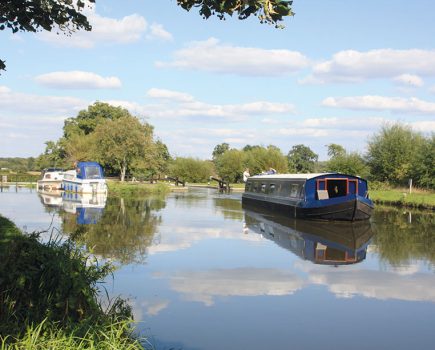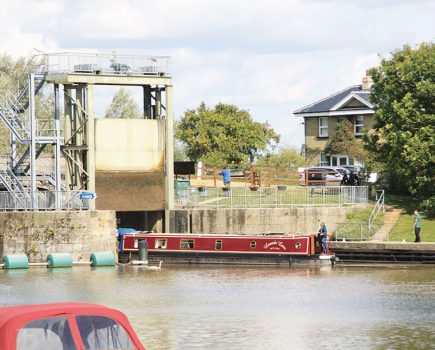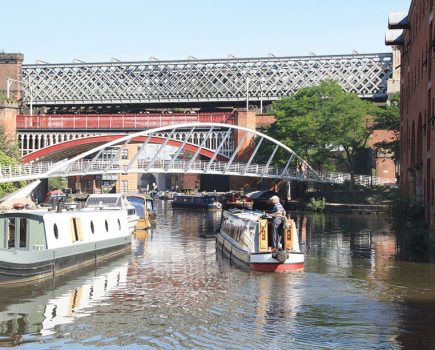Only once has a boat taken the Crick Show title three times in a row, but when you look at what’s gone into Silver Melody, you start to see why it has been three times a winner

Words: Adam Porter
Pictures: Andy R Annable
There’s something special about winning something three times. There must be, because someone somewhere decided it deserved a special name, a hat-trick. You can understand why – a player scoring three goals in a football match doesn’t happen very much, while taking three wickets in three balls in cricket is yet more special.

Even rare still, however, is winning the vote for Favourite Boat at the Crick Boat Show three years in a row. In fact, it had never been done until this year, when the Boating Leisure Services picked up the hat-trick, thanks to Silver Melody.
This boat is recognisably from the same stable as the Boating Leisure Services’ winners from the past two years, but there’s one crucial difference – Columbus and Shackleton were both spec boats designed to show what the firm could do. Silver Melody, on the other hand, was commissioned by Sally and Steve Sumner who had their own ideas about what they wanted. That perhaps makes things trickier, especially for a show boat.
The vote shows Silver Melody is yet another very appealing boat from the company. There are flashes of inspired design too, with the boat featuring some clever solutions to the challenges set by the owners.

EXTERIOR
Silver Melody is based on a Tyler Wilson shell, and in one sense it’s fairly standard, There are no recessed panels and no rivets, for example; and the bow is the standard Tyler Wilson rather than their curvier Josher-inspired one. It’s still a very attractive boat – the lines are good, it sits in the water well and that bow has a substantial stem post and sense of purpose. It just goes to show that you can have a pretty boat without going all-out Josher.

There’s nice detailing, with a boatman’s beam on the roof and scrolls at the end of the cants and the handrails. There are a couple of glazed pigeon boxes, too. As you’d expect from Tyler Wilson, the quality of the steelwork is excellent.
On a practical level, the gas locker is in the nose, there’s a locker across the front of the well deck, which provides storage as well as access to the bow thruster, and there’s a stainless steel water tank under the deck.
At the stern, there are lockers on both sides of the semi-trad deck providing somewhere to keep mooring pins and the like, as well as somewhere to sit. Brass bulkhead lights are positioned at both the bow and the stern.

A look at the roof hints at the high-tech equipment on board. The white satellite dome doesn’t really add anything to the boat’s style, but should be able to find TV channels easily enough. A fin-shaped 4G antenna is more subtle and there are four flexible solar panels fixed to the roof.
The colour scheme is green and blue, which the Sumners had on their previous boat, (although this green is a few shades darker, so dark, in fact, that in some lights you’d be forgiven for thinking it was black). The boat was painted by Mike Looby, who is based alongside Boating Leisure Services at Heyford Fields, and he’s done a good job.

The trim is all brass which provides quite a traditional look. The windows, by Channelglaze, have a matching finish. The portholes are the latest version of their fully opening ports, with double glazed inserts.
LAYOUT AND FIT-OUT
This is a standard layout boat with the saloon at the bow, followed by an extremely clever multi-function dinette. The galley comes next, followed by a walk-through shower room. The cabin is at the stern.

The fit-out follows a tried and tested Boating Leisure Services formula, using a combination of oak shadow gap tongue and groove below the gunwales and on the ceiling, teamed with painted cabin sides. It was this look which Sally and Steve fell in love with in the firm’s first boat. It almost goes without saying the quality of the joinery is excellent.
The floor is Karndean, chosen by the owners as they have dogs. There are LED lights under the gunwales, fitted with colour-changing control boxes.

SALOON AND DINETTE
Steps containing storage bring you from the well deck into the saloon, and they have the best looking and most tactile hand rail you’re likely to see. On one side, there’s a Hamlet stove with a double insulated flue, while on the other there’s a cupboard with a glazed unit above.
On the inside of the cupboard door is a rechargable Dyson vacuum cleaner, one of Sally’s top requirements. It’s constantly plugged in and charging.

Seating comes from a couple of captain’s chairs and, opposite them, there’s an under the gunwale unit that contains the TV which rises up either at the touch of a button on the side of the unit, or by using a remote control fob.
The dinette is one of the more intelligent pieces of design on the boat. While most boats have a choice between an L-shaped seating area or a Pullman dinette, Sally and Steve wanted both. They left BLS’s joiner, James Attwood, to come up with something and his solution really does give the best of both worlds.

In L-shaped mode, the seating looks pretty normal and acts to extend the saloon, but the long side of the L is moveable on hefty rubber casters, so it can be swung around and locked into place to form a Pullman dinette. What’s more, the freestanding table (which means it can also be taken outside and used on the towpath) is stored neatly in the back of the unit. In addition, the backrest drops down to complete another conversion into a guest bed. The dinette alone will almost certainly have won plenty of votes at the show.
GALLEY
The galley is smart and stylish, with oak doors and black granite worktops. The stainless steel sink has a tap whose angle matches the tumblehome of the cabin sides. There’s plenty of equipment – a freezer is at the end of the dinette and there are appliances by Capel, including an oven, microwave and a four-burner hob.

Under the sink, there’s a Klarstein dishwasher, which uses just seven litres a time. On the opposite side of the galley, there’s a cupboard which contains a slimline Hoover washing machine.
Next to the oven, on the bulkhead, there’s a wine rack and some of James Attwood’s trademark pull-out units, making the most of the space available. Above the oven, there’s a slot for storing a chopping board. There are magic corner units in two of the main cupboards.

SHOWER ROOM
Sally and Steve had one major request for the shower room and that was for two different types of toilet. The main one is a Vetus macerating unit with a holding tank behind and under the bed, but they knew there are occasions when another loo comes in handy (what if ther’re iced in and can’t get to the pump-out machine?). The unit under the large white basin pulls out to reveal a Thetford Porta Potti.
The shower is a good sized quadrant, lined with dark laminate, and with an infinity shower tray. Alongside there’s another pull-out unit, with a finrad at the bottom to turn it into a useful airing cupboard.

CABIN
The bed is inline and lifts on gas struts to provide access to a big, carpeted and illuminated storage area. Because it’s so easily accessible, this area is far more usable.

Above the head of the bed are high level cupboards with reading lights underneath and a clever folding shelf. It pulls down and flips out, to give somewhere for a book or your glasses. Just don’t forget it’s there when you sit up…
At the foot of the bed there’s a chest of drawers and there’s also a wardrobe. There’s also a second TV and a glazed pigeon box for extra light.
TECHNICAL

Silver Melody is powered by a Beta 50 engine, which is bigger than you might expect for this size of boat. It’s been chosen largely because of the hefty electrical system. There’s also a Vetus 75kgf bow thruster.
Last year’s winning boat, Columbus, was believed to be the first narrowboat in the UK to have Victron’s lithium battery pack on board. The owners of this boat have opted for a similar system. There are four lithium batteries, each of 160Ah, so there’s a very substantial amount of power available. What’s more, the boat has a 24-volt system rather than a 12-volt one (Boating Leisure Services are long time proponents of 24v because it’s more robust and offers better performance), so each appliance pulls half the current.

The advantages of lithium batteries are that you can run them right down to 80 percent discharged. That gives you almost twice the available power of lead acid batteries, which are damaged if they go below 50 percent. Lithiums continue to deliver their full voltage right up to the last moment. If you had a more everyday set up, with lead acid batteries and a 12-volt system and wanted an equivalent output, you’d need a battery bank totalling 1100Ah.
The boat was moored for five days at the Crick Show, without running the engine, and the battery bank was still over 50 percent. Of course, the four solar panels on the roof, each of 80 watts, help.
Lithium batteries also charge quickly. This bank can go from zero to 100 percent in three hours. That brings us back to the Beta 50, fitted with two 120-amp alternators, to charge the domestic bank. A box of tricks continually monitors the system, including what’s going in and what’s coming out. It can shut down the alternators, the batteries, and the inverter if it senses something is amiss.

One major disadvantage with lithium batteries, however, is the price. Each of the four batteries costs around £1,500. That’s a significant part of any budget, but it looks less expensive when you consider their life, said to be at least ten times as long as normal batteries, which means 20 to 30 years. The likelihood is when they do finally need to be replaced, the price of such batteries will have dropped significantly as the technology is more widely used.
To turn the battery power into a 240-volt supply, there’s a 5kW Victron Quattro inverter. This is part of a sophisticated system for when you’re connected to shore power because it can combine the shoreline with the battery output, meaning there’s 9kW of power available at any one moment.

The whole boat is connected to the internet, so Steve can monitor what’s going on remotely. He can check the state of the batteries, see what the solar panels are doing, and turn on the Eberspächer heating from his smartphone. Other high tech gadgets include a Wi-F1 router and an Apple TV system.
ON THE WATER
As you might expect from a Tyler Wilson shell, the handling is first class. The boat responds to the tiller and turns very well. An Axiom propeller means there’s little wash and the boat stops remarkably quickly when put into reverse.

The Morse control is comfortably within reach and the same control has the button for the Vetus bow thruster on it. As a 75kgf model, it really does deliver some grunt.
There’s plenty of room on the semi-trad stern deck for the crew and the lockers provide quite comfortable places to sit.

CONCLUSION
People always want to know why a particular boat won the Crick vote and it’s not always easy to pin down. After all, a wide variety of boats have won over the years. The competition was tough in 2016. The boat that came second, Betty, built to look like a working boat under cloths, was in many ways more eye-catching.
But in the end, Silver Melody probably appealed to more people because they could imagine themselves using it. It has a nice feeling inside, the build quality is exceptional and there are some elegant innovations.
Of course, a boat like this costs a lot of money – £168,000 to be precise. But quality costs, and this boat is loaded with some of the most advanced electrics you’ll find anywhere.
Whatever the secret, Boating Leisure Services certainly seem to know it. We thought winning two years in a row was an achievement, but a hat-trick is special, like Silver Melody.
Image(s) provided by:
Archant







